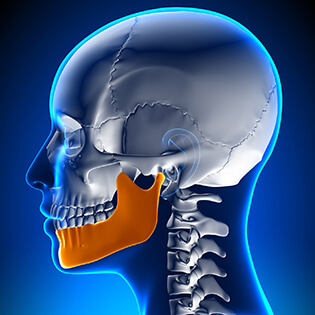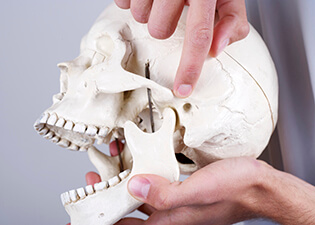Jawbone Loss Prevention
 Jawbone Density Issues
Jawbone Density Issues
Bone deterioration in the Maxilla (upper jaw) and Mandible (lower jaw) is a serious issue that, unfortunately, many patients don't understand well. Adequate jawbone structure and density are critical for the retention of teeth, maintaining good oral health, allowing for optimal tooth replacement options, and obtaining dentures that fit well, feel good, and preserve basic dental function.
 Knowledgeable Patients
Knowledgeable Patients
Unfortunately, most of the intricacies and important information to know about bone density doesn’t gain people's attention until it happens to them. Bone density problems involving internal resorption and rapid bone deterioration begin very suddenly. It is this patient group that becomes knowledgeable, after the fact, about the relationship between sensible, informed dental treatment and jawbone preservation
 Jawbone Integrity - Understanding Bone Stimulation
Jawbone Integrity - Understanding Bone Stimulation
Natural teeth are attached to our jawbones via a root structure. Depending on the location and size of any given tooth, these root structures will vary in size, depth, and complexity. The behaviors of biting and chewing (forces of mastication) produce physical stimulation of each and every root structure which, in turn, stimulates the immediate bone material that the root is attached to. As long as we have our natural teeth and the absence of any disease process, our mandibular (lower jaw) and maxillary (upper jaw) bone structures can be expected to remain healthy and intact.
Common Causes of Jawbone Deterioration
Numerous events, dental conditions, oral disease, and a patient's choice of dental treatment can compromise important jawbone characteristics. Some of the more common causes are listed here:
- Extractions: As soon as an adult tooth is removed, and not replaced, bone stimulation ceases for that particular site.
- Trauma: Events that cause a tooth to be knocked out or broken off to the extent that no biting surface exists (such as broken off at the gum line), bone stimulation ceases.
- Gross Malalignment: Alignment issues due to growth factors, trauma, and untreated extractions can cause situations where certain tooth structures do not have an opposing tooth structure. The unopposed tooth may super erupt and also undergo underlying bone deterioration.
- Bridgework: Custom bridges are a popular treatment for replacing missing teeth. The bone structure underlying the span of missing teeth will undergo deterioration, while only the anchoring teeth continue to provide important bone stimulation.
- Dentures: Low cost, unanchored dentures are designed to ride or rest on top of gum tissue. Contrary to what many people want to believe, there is no direct stimulation of jaw bone material. Rather, there may be accompanying loss of gum tissue while the all important underlying bone structure slowly resorbs.
- Bite Occlusion Abnormalities: Dentists routinely maintain a close focus on bite and occlusion. Assessment of the biting surfaces assures normal bite characteristics, overall dental function, and patient comfort. Long standing occlusal issues arising from lack of treatment, normal wear and tear, and certain TMJ/TMD problems can cause abnormal physical forces that disrupt the balance of the occlusal relationship. Therefore, significant, bone deterioration can occur with certain tooth structures.
- Advanced Gum Disease: Periodontitis, if left untreated, causes wholesale devastation of all tissues at the site of infection. Bone tissue, gingival tissue, and connective tissue all undergo destructive changes that may or may not be fully restorable.
Preventing or Limiting Jawbone Deterioration - Resorption
Using the format outlined above describing different cause and effect relationships with bone loss, treatment suggestions are listed below:
- Extractions: Depending on the site and need (e.g. wisdom teeth versus anterior, front, tooth) replacement of the root-jawbone stimulation is best restored via an implant.
- Trauma: A combination of single or multiple implants is efficient, as is a fixed bridge.
- Gross Malalignment: Alignment should be restored using whatever treatments are appropriate (orthodontics, tooth extractions, implants, onlays, etc.).
- Bridgework: Follow your dentist's best recommendation for type, size, and location.
- Dentures: Edentulous patients should consider implant anchored dentures whenever possible, using the largest practical number of implants possible (2 is good, 4 is better, more than 4 better still).
- Bite Occlusion Abnormalities: Sometimes difficult to treat without intensive study and use of articulators. Treatments might include new fillings, onlays, new crowns, bite appliances, night guards (treatment for bruxism and teeth-clenching).
- Advanced Gum Disease: Seek immediate treatment. Stopped and controlled early enough, a patient may have treatment choices that can restore a substantial percentage of function. Tissue grafting and specialized implants are possible in some cases.
 Healthy Jawbone Structures - The Natural Order of Things
Healthy Jawbone Structures - The Natural Order of Things
Mother Nature developed a system of opposing physical forces that promotes optimal dental function and long term oral health. Disruptions that occur, as outlined above, have the potential of altering the physical forces that science has proven to be essential. Jawbone integrity is best maintained by keeping a mindful eye on the physical forces that should be operating on each and every tooth in a patient's mouth.
 Questions about Maxilla and Mandible Health Maintenance?
Questions about Maxilla and Mandible Health Maintenance?
Patients with concerns or questions about jawbone health not addressed here are invited to contact Dr. Petulla or Dr. Kazemi directly with our online Ask the Dentist form. Their experience and focus on reconstructive treatments associated with diseased or deteriorated bone structures may provide the information needed for making an informed decision about treatment.
